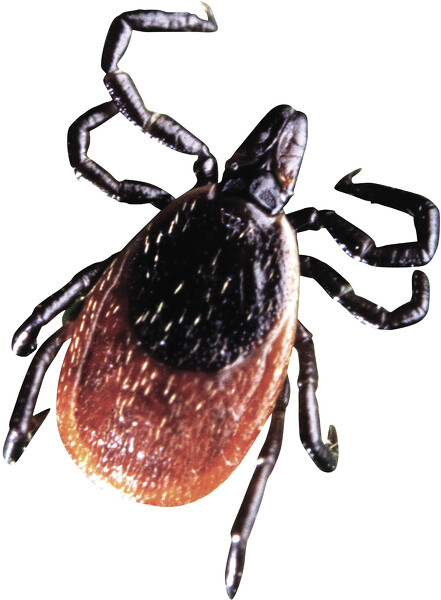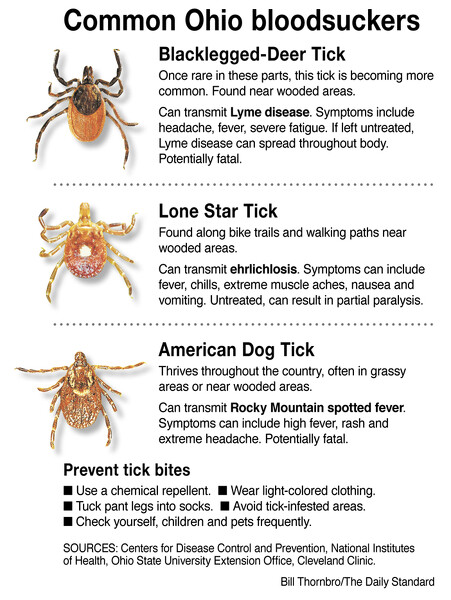
A magnified view of a blacklegged tick, also know as a deer tick.
CELINA - The number of Ohioans who contracted Lyme disease nearly doubled last year, surging from 552 cases in 2022 to 1,079 cases in 2023, according to the Ohio Department of Health.
High cases are expected again this year as disease-causing tick populations should be bountiful following Ohio's second warmest winter on record.
Lyme disease affects both humans and dogs and is caused by a bacterium called Borrelia burgdorferi. It's transmitted by a tick called the blacklegged tick, which is also known as the deer tick, per ODH. The bacteria are normally found in mice, squirrels and other small mammals without causing illness.
Due to factors such as climate change and human encroachment on wild areas, ticks have been on the rise throughout the Midwest for the past 5-10 years, said Dr. Don Cipollini Jr., a biological sciences professor at Wright State University.
"One of the things that holds back ticks and other insects are cold winters," Cipollini said. "The colder the winter, the more the ticks sort of get knocked back and have to kind of restart in the spring. So the milder the winter, the less dieback they experience and the quicker and faster start and bigger start they can get to the season."
Ohio experienced its second warmest winter
on record in 2023-2024, with a mean temperature of 7.4 degrees above the 20th-century mean, according to Ohio State Climate Office.
Those conditions allowed ticks to move northward and avoid the standard seasonal restart, Cipollini said.
"They're not getting knocked back as hard every winter, and so that's allowing them
to spread northward and build up larger populations," he said. "That's also coupled with having things like high deer populations in
the state and increasingly tame deer that come into suburban areas."
Deer as well as rodents carry ticks into human habitations.
"Increasing deer, climate change, human encroachment on wild nature, all those things contribute to increases in tick presence and tick bites," Cipollini said.

Common ticks in Ohio
Deer ticks, wood ticks and lone star ticks are the most common ticks in Ohio. Not all ticks are infected with disease-causing germs - about 20% to 30% of the blacklegged tick nymphs that emerge in the Northeast and Midwest this spring and into summer will be carrying the bacteria that causes Lyme disease, experts estimate.
Yet it's the deer ticks that primarily carry Lyme disease.
Lyme disease symptoms tend to start between three and 30 days after a bite occurs and can include fever, headache, fatigue and a bull's-eye-like rash.
"There's often a symptom associated with a tick that's bitten you (and) infected, and that's this certain rash you get in the vicinity of the bite," Cipollini said. "It's round and red. It's a patch. People call it a bull's eye. If you have the tick bite in the center, there's a red rash and a ring around that bite."
A bull's eye rash indicates that a person has been bitten by a tick that may have been carrying Lyme disease.
"Not everybody gets that particular symptom, even if they did get bitten by a tick like that, so that's not the only (indicator)," Cipollini said.
Following a tick bite, those infected with Lyme disease may also start to experience fevers, unexplained aches and pains and general malaise, Cipollini added.
"You just feel bad, you know?" he said. "These are the sort of symptoms to watch out for, especially if you've seen a bite like that on you or know that you've had deer ticks on you. You should watch for those kinds of symptoms and then get to the doctor."
Antibiotics can cure most cases of Lyme disease, according to the National Institute of Allergy and Infectious Diseases. The sooner treatment begins, the quicker and more complete the recovery. After treatment, some patients may still have muscle or joint aches and nervous system symptoms. This is called post-Lyme disease syndrome.
In addition to Lyme disease, ticks can carry a host of other diseases, Cipollini said.
"There's one called babesiosis, which is kind of an interesting disease," he said. "These all kind of cause similar symptoms - fever, malaria-like symptoms, just feeling bad, nauseousness, headaches."
Another disease vectored by ticks - specifically the lone star tick - causes a meat allergy called alpha-gal syndrome, which can be temporary or lifelong, Cipollini said.
"A bite with an infected lone star tick causes you to react to a particular carbohydrate that's found in red meat that you basically develop an allergic reaction to this carbohydrate in red meat," he said. "It's commonly called the alpha-gal syndrome, which is named after the particular carbohydrate that you react to. That's one that kind of can sneak up on you."
Those who've contracted the illness may not even realize they have it because symptoms don't kick in until about eight hours after eating red meat.
"You get these symptoms and you kind of don't necessarily connect it to the hamburger you had eight hours ago," he continued. "So that's an interesting one. There's a variety, with Lyme disease on the top and then a few of these others of less frequency, but nonetheless important."
To avoid a tick bite and its concomitant diseases, Cipollini recommends regularly wearing tick repellent and long clothes when outdoors.
"Using bug repellent is very important," he said. "Anytime you're going to go into an area where you might be (in contact with) long grass, brush trees, hikes where you're going to brush against foliage and things like that, there's a chance of a tick getting on you. If you were to walk through an old meadow or a prairie, with just exposed legs, it's almost a guarantee that once you came out the other side, you're going to have some ticks on you."
Before entering high-risk tick areas, a person should put on long clothes, tuck pant legs into socks and then apply bug repellent to the socks and lower pant legs.
"That's like the best thing you can do to sort of keep them off of you, if you can," he said. "The second thing is to always do a tick check when you're done."
The Ohio Department of Health recommends conducting a full-body check for ticks using a hand-held or full-length mirror to view all body parts upon return from tick-infested areas.
Ticks can ride into the home on clothes, then attach to a person later. Hence it's important to examine pets, clothing and bags.
Also, ODH recommends tumble drying clothes on high heat for 10 minutes to kill ticks.
"If the clothes are damp, additional time may be needed," ODH's website states. "If the clothes require washing, hot water is recommended."
The best way to remove a tick is to use fine-tipped tweezers to grasp the parasite as close to the skin's surface as possible. ODH offers the following instructions:
• Pull away from your skin with steady, even pressure.
• Don't twist or jerk the tick; this can cause the mouth-parts of the tick to break off and remain in the skin. If this happens, remove the mouth-parts with tweezers. If unable to remove the mouth-parts with tweezers, leave it alone and let the skin heal.
•Dispose of a live tick by putting it in alcohol, placing it in a sealed bag, wrapping it tightly in tape, or flushing it down the toilet. Never crush a tick with your fingers.
•Wash your hands and the bit area with soap and water.
•Do not use petroleum jelly, a hot match, nail polish or any other folk remedies to remove a tick. Those methods do not work.
- The Associated Press contributed to this article.
